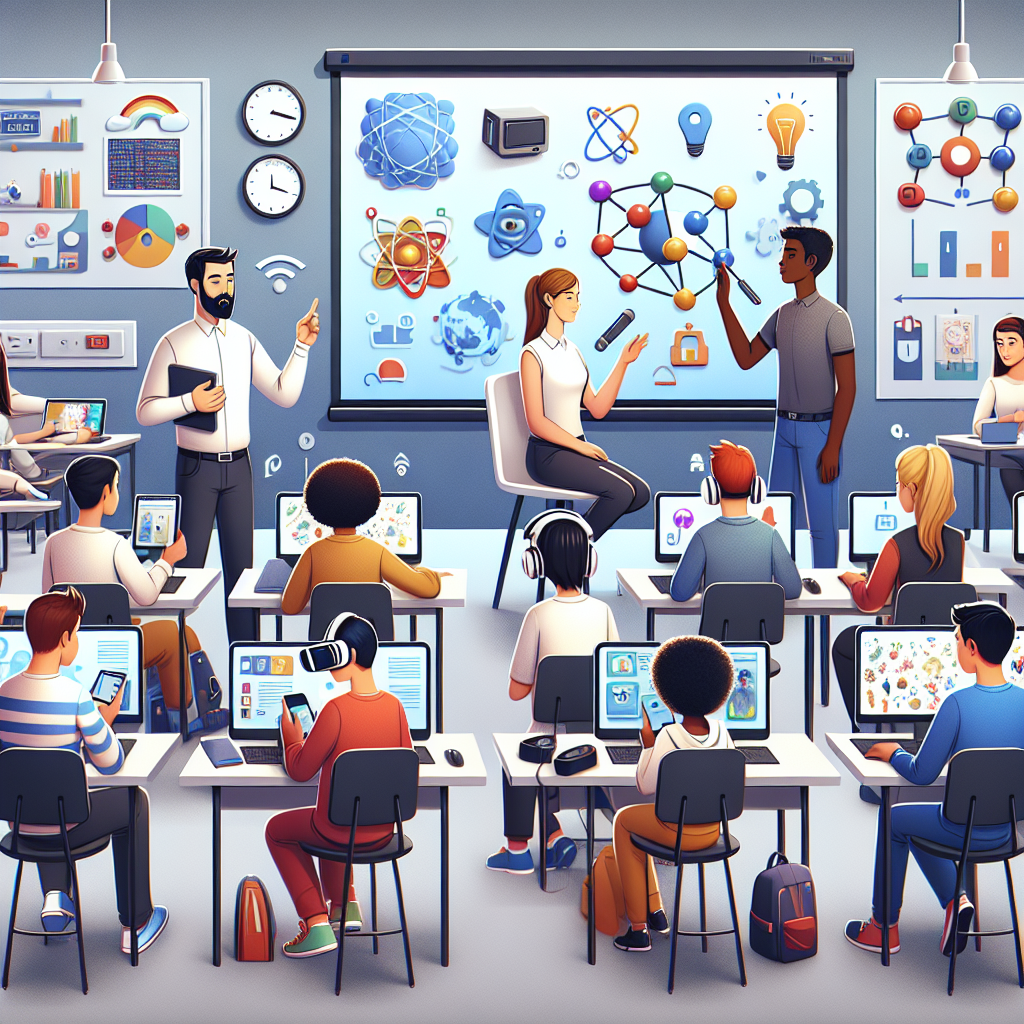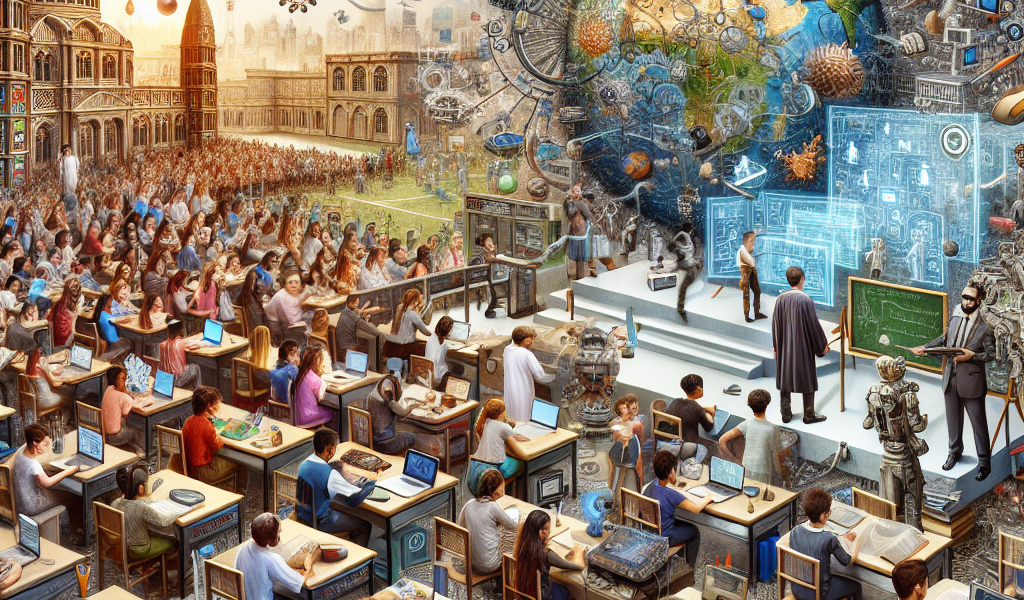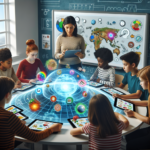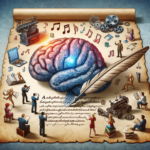-
Table of Contents
“Empowering Minds: Technology as the Catalyst for Educational Excellence”
Introduction

The Role of Technology in Enhancing Educational Outcomes
In the contemporary educational landscape, technology has emerged as a pivotal force in transforming traditional learning paradigms. The integration of digital tools and resources into educational settings has revolutionized the way knowledge is imparted and acquired, fostering a more interactive, personalized, and efficient learning experience. From the use of interactive whiteboards and online learning platforms to the implementation of artificial intelligence and virtual reality, technology has significantly broadened the horizons of educational possibilities. This evolution not only facilitates access to a vast array of information and resources but also supports diverse learning styles, promotes student engagement, and enhances the overall quality of education. As educational institutions continue to embrace technological advancements, the potential for improved educational outcomes becomes increasingly attainable, paving the way for a more informed and capable future generation.
The Impact of Artificial Intelligence on Personalized Learning
Artificial intelligence (AI) is revolutionizing various sectors, and education is no exception. The integration of AI into educational systems is transforming the way students learn and teachers instruct, making personalized learning more accessible and effective. This shift is not just a fleeting trend but a significant evolution in the educational landscape, promising to enhance educational outcomes in unprecedented ways.
One of the most compelling aspects of AI in education is its ability to tailor learning experiences to individual students. Traditional classroom settings often struggle to address the diverse needs of students, as teachers are tasked with managing large groups with varying abilities and learning styles. AI, however, can analyze vast amounts of data to identify each student’s strengths, weaknesses, and preferences. This data-driven approach allows for the creation of customized learning plans that adapt in real-time, ensuring that each student receives the support they need to succeed.
Moreover, AI-powered tools can provide immediate feedback, a crucial element in the learning process. In a conventional classroom, students might have to wait days or even weeks to receive feedback on their assignments. AI can instantly evaluate student work, offering constructive criticism and suggestions for improvement. This immediacy helps students understand their mistakes and learn from them more effectively, fostering a more dynamic and responsive educational environment.
In addition to personalized learning, AI also plays a significant role in identifying and addressing learning gaps. Through continuous assessment and analysis, AI can pinpoint areas where students are struggling and recommend targeted interventions. For instance, if a student consistently performs poorly in mathematics, AI can suggest additional resources, such as tutorials or practice exercises, to help them improve. This proactive approach ensures that learning gaps are addressed promptly, preventing them from widening over time.
Furthermore, AI can enhance the role of teachers by automating administrative tasks, allowing educators to focus more on teaching and less on paperwork. Tasks such as grading, attendance tracking, and scheduling can be efficiently managed by AI systems, freeing up valuable time for teachers to engage with students and develop innovative teaching strategies. This shift not only improves the quality of education but also reduces teacher burnout, a significant issue in the profession.
The benefits of AI in education extend beyond the classroom. For students with disabilities, AI offers tools that can make learning more accessible. Speech recognition software, for example, can assist students with dyslexia, while AI-driven apps can help those with visual or hearing impairments. By breaking down barriers to education, AI ensures that all students have the opportunity to reach their full potential.
However, the integration of AI in education is not without its challenges. Concerns about data privacy and the ethical use of AI are paramount. Ensuring that student data is protected and used responsibly is crucial to maintaining trust in these technologies. Additionally, there is the risk of over-reliance on AI, which could potentially undermine the human element of teaching. Striking a balance between leveraging AI’s capabilities and preserving the essential human touch in education is vital.
In conclusion, the impact of artificial intelligence on personalized learning is profound and multifaceted. By tailoring educational experiences to individual needs, providing immediate feedback, identifying learning gaps, and automating administrative tasks, AI has the potential to significantly enhance educational outcomes. While challenges remain, the promise of a more personalized, efficient, and inclusive educational system is an exciting prospect that holds great promise for the future.
Virtual Reality: Transforming Classroom Experiences
Virtual reality (VR) is rapidly transforming classroom experiences, offering students and educators unprecedented opportunities to enhance educational outcomes. As technology continues to evolve, VR has emerged as a powerful tool that can bridge the gap between theoretical knowledge and practical application. By immersing students in interactive and engaging environments, VR is revolutionizing the way education is delivered and received.
One of the most significant advantages of VR in education is its ability to create immersive learning experiences. Traditional teaching methods often rely on textbooks and lectures, which can sometimes fail to capture students’ attention or fully convey complex concepts. In contrast, VR allows students to step into a three-dimensional world where they can interact with the subject matter in a more tangible and meaningful way. For instance, instead of merely reading about ancient civilizations, students can virtually explore historical sites, witnessing the grandeur of the pyramids or the intricacies of Roman architecture firsthand. This level of immersion not only makes learning more enjoyable but also helps students retain information more effectively.
Moreover, VR can cater to diverse learning styles, making education more inclusive. Some students thrive in visual and kinesthetic learning environments, where they can see and manipulate objects to understand concepts better. VR provides these students with the opportunity to engage with the material in a way that suits their learning preferences. For example, in a biology class, students can virtually dissect a frog, observing its anatomy in detail without the ethical and logistical challenges of using real specimens. This hands-on approach can demystify complex subjects and make them more accessible to all students.
In addition to enhancing individual learning experiences, VR also fosters collaboration and teamwork. Many VR applications are designed to be used in group settings, where students can work together to solve problems or complete tasks. This collaborative aspect of VR can help develop essential soft skills such as communication, critical thinking, and problem-solving. For instance, in a virtual chemistry lab, students can collaborate to conduct experiments, sharing their observations and hypotheses in real-time. This not only reinforces their understanding of scientific principles but also prepares them for real-world scenarios where teamwork is crucial.
Furthermore, VR can provide students with experiences that would otherwise be impossible or impractical. For example, aspiring medical professionals can practice surgical procedures in a virtual environment, gaining valuable experience without the risks associated with real-life operations. Similarly, geography students can embark on virtual field trips to remote locations, studying ecosystems and geological formations without leaving the classroom. These experiences can broaden students’ horizons and inspire them to pursue careers in fields they might not have considered otherwise.
Despite its many benefits, the integration of VR into education is not without challenges. The cost of VR equipment and the need for technical support can be significant barriers for some schools. However, as technology advances and becomes more affordable, these obstacles are likely to diminish. Additionally, educators must be adequately trained to use VR effectively in their teaching. Professional development programs and resources can help teachers harness the full potential of VR, ensuring that it enhances rather than detracts from the learning experience.
In conclusion, virtual reality is transforming classroom experiences by making learning more immersive, inclusive, and collaborative. As VR technology continues to evolve, its potential to enhance educational outcomes will only grow. By embracing VR, educators can provide students with unique and engaging learning opportunities that prepare them for the challenges of the future.
The Benefits of Online Learning Platforms in Modern Education
In recent years, the landscape of education has undergone a significant transformation, largely driven by the advent of technology. One of the most notable advancements in this realm is the rise of online learning platforms, which have revolutionized the way students access and engage with educational content. These platforms offer a myriad of benefits that enhance educational outcomes, making learning more accessible, personalized, and efficient.
To begin with, online learning platforms break down geographical barriers, allowing students from all corners of the globe to access high-quality education. This democratization of knowledge means that a student in a remote village can now learn from the same esteemed professors as their peers in urban centers. Consequently, this increased accessibility helps bridge the educational divide, providing opportunities for those who might otherwise be left behind.
Moreover, the flexibility offered by online learning platforms is unparalleled. Traditional classroom settings often require students to adhere to rigid schedules, which can be challenging for those juggling multiple responsibilities, such as work or family commitments. In contrast, online learning allows students to learn at their own pace and on their own time. This flexibility not only accommodates diverse learning styles but also fosters a sense of autonomy and self-discipline, essential skills for lifelong learning.
In addition to flexibility, online learning platforms offer a wealth of resources that cater to various learning preferences. From video lectures and interactive simulations to discussion forums and digital textbooks, these platforms provide a rich, multimedia learning experience. This variety ensures that students can engage with the material in a way that resonates with them, thereby enhancing comprehension and retention. Furthermore, the ability to revisit and review content as needed allows for a deeper understanding of complex concepts.
Another significant advantage of online learning platforms is the potential for personalized learning. Advanced algorithms and data analytics enable these platforms to tailor educational content to individual students’ needs. By tracking progress and identifying areas of difficulty, these systems can recommend targeted resources and exercises, ensuring that each student receives the support they need to succeed. This personalized approach not only boosts academic performance but also fosters a more engaging and motivating learning experience.
Collaboration and communication are also greatly enhanced through online learning platforms. Virtual classrooms and discussion boards facilitate interaction among students and instructors, fostering a sense of community and collaboration. These platforms often include features such as real-time messaging and video conferencing, which allow for immediate feedback and support. This connectivity ensures that students are not isolated in their learning journey but are part of a dynamic, interactive educational environment.
Furthermore, online learning platforms are continually evolving, incorporating the latest technological advancements to improve the learning experience. For instance, the integration of artificial intelligence and machine learning can provide more accurate assessments and personalized recommendations. Similarly, virtual and augmented reality technologies offer immersive learning experiences that can bring abstract concepts to life. As these technologies continue to develop, the potential for even greater educational outcomes is immense.
In conclusion, the benefits of online learning platforms in modern education are manifold. By providing greater accessibility, flexibility, and personalized learning experiences, these platforms are transforming the educational landscape. They not only enhance academic performance but also equip students with the skills and knowledge needed to thrive in an increasingly digital world. As technology continues to advance, the role of online learning platforms in shaping the future of education will undoubtedly become even more significant.
Conclusion
The role of technology in enhancing educational outcomes is multifaceted and significant. It facilitates personalized learning experiences, enabling students to learn at their own pace and according to their individual needs. Technology also provides access to a vast array of resources and information, fostering a more engaging and interactive learning environment. Additionally, it supports collaboration and communication among students and teachers, both locally and globally. The integration of technology in education can lead to improved student engagement, better retention of information, and the development of critical 21st-century skills. However, it is essential to address challenges such as the digital divide and ensure that both educators and students are adequately trained to maximize the benefits of technological tools. Overall, when effectively implemented, technology has the potential to significantly enhance educational outcomes and prepare students for future success.





